Early activation of sphingosine kinase in mast cells and recruitment to FcepsilonRI are mediated by its interaction with Lyn kinase
- PMID: 15367693
- PMCID: PMC516729
- DOI: 10.1128/MCB.24.19.8765-8777.2004
Early activation of sphingosine kinase in mast cells and recruitment to FcepsilonRI are mediated by its interaction with Lyn kinase
Abstract
Sphingosine kinase has been recognized as an essential signaling molecule that mediates the intracellular conversion of sphingosine to sphingosine-1-phosphate. In mast cells, induction of sphingosine kinase and generation of sphingosine-1-phosphate have been linked to the initial rise in Ca(2+), released from internal stores, and to degranulation. These events either precede or are concomitant with the activation of phospholipase C-gamma and the generation of inositol trisphosphate. Here we show that sphingosine kinase type 1 (SPHK1) interacts directly with the tyrosine kinase Lyn and that this interaction leads to the recruitment of this lipid kinase to the high-affinity receptor for immunoglobulin E (FcepsilonRI). The interaction of SPHK1 with Lyn caused enhanced lipid and tyrosine kinase activity. After FcepsilonRI triggering, enhanced sphingosine kinase activity was associated with FcepsilonRI in sphingolipid-enriched rafts of mast cells. Bone marrow-derived mast cells from Lyn(-/)(-) mice, compared to syngeneic wild-type cells, were defective in the initial induction of SPHK1 activity, and the defect was overcome by retroviral Lyn expression. These findings position the activation of SPHK1 as an FcepsilonRI proximal event.
Figures
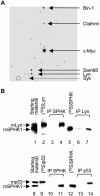


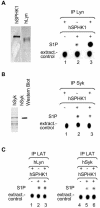
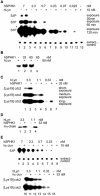
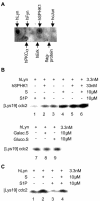

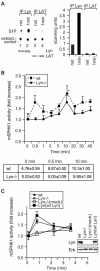
Similar articles
-
IgE-dependent activation of sphingosine kinases 1 and 2 and secretion of sphingosine 1-phosphate requires Fyn kinase and contributes to mast cell responses.J Biol Chem. 2006 Feb 3;281(5):2515-25. doi: 10.1074/jbc.M508931200. Epub 2005 Nov 29. J Biol Chem. 2006. PMID: 16316995
-
Structure-function analysis of Lyn kinase association with lipid rafts and initiation of early signaling events after Fcepsilon receptor I aggregation.Mol Cell Biol. 2001 Dec;21(24):8318-28. doi: 10.1128/MCB.21.24.8318-8328.2001. Mol Cell Biol. 2001. PMID: 11713268 Free PMC article.
-
PTPalpha activates Lyn and Fyn and suppresses Hck to negatively regulate FcepsilonRI-dependent mast cell activation and allergic responses.J Immunol. 2010 Nov 15;185(10):5993-6002. doi: 10.4049/jimmunol.1001261. Epub 2010 Oct 13. J Immunol. 2010. PMID: 20944008
-
The role of Src family kinases in mast cell effector function.Novartis Found Symp. 2005;271:39-47; discussion 47-53, 95-9. Novartis Found Symp. 2005. PMID: 16605127 Review.
-
What precedes the initial tyrosine phosphorylation of the high affinity IgE receptor in antigen-activated mast cell?FEBS Lett. 2010 Dec 15;584(24):4949-55. doi: 10.1016/j.febslet.2010.08.045. Epub 2010 Sep 7. FEBS Lett. 2010. PMID: 20828563 Review.
Cited by
-
Development, migration, and survival of mast cells.Immunol Res. 2006;34(2):97-115. doi: 10.1385/IR:34:2:97. Immunol Res. 2006. PMID: 16760571 Free PMC article. Review.
-
Sphingosine-1-phosphate induces development of functionally mature chymase-expressing human mast cells from hematopoietic progenitors.FASEB J. 2009 Oct;23(10):3506-15. doi: 10.1096/fj.08-128900. Epub 2009 Jun 17. FASEB J. 2009. PMID: 19535686 Free PMC article.
-
Sphingosine-1-phosphate and other lipid mediators generated by mast cells as critical players in allergy and mast cell function.Eur J Pharmacol. 2016 May 5;778:56-67. doi: 10.1016/j.ejphar.2015.02.058. Epub 2015 May 2. Eur J Pharmacol. 2016. PMID: 25941085 Free PMC article. Review.
-
Deciphering the structure and function of FcεRI/mast cell axis in the regulation of allergy and anaphylaxis: a functional genomics paradigm.Cell Mol Life Sci. 2012 Jun;69(12):1917-29. doi: 10.1007/s00018-011-0886-0. Epub 2011 Dec 7. Cell Mol Life Sci. 2012. PMID: 22146792 Free PMC article. Review.
-
Molecular mechanisms of regulation of sphingosine kinase 1.Biochim Biophys Acta Mol Cell Biol Lipids. 2018 Nov;1863(11):1413-1422. doi: 10.1016/j.bbalip.2018.08.015. Epub 2018 Aug 30. Biochim Biophys Acta Mol Cell Biol Lipids. 2018. PMID: 30591148 Free PMC article. Review.
References
-
- Albrecht, B., M. Woisetschlager, and M. W. Robertson. 2000. Export of the high affinity IgE receptor from the endoplasmic reticulum depends on a glycosylation-mediated quality control mechanism. J. Immunol. 165:5686-5694. - PubMed
-
- Baumruker, T., G. G. Pendl, and E. E. Prieschl. 1997. Gene regulation after Fc epsilon RI stimulation in the murine mast cell line CPII. Int. Arch. Allergy Immunol. 113:39-41. - PubMed
-
- Baumruker, T., and E. E. Prieschl. 2002. Sphingolipids and the regulation of the immune response. Semin. Immunol. 14:57-63. - PubMed
-
- Billich, A., F. Bornancin, P. Devay, D. Mechtcheriakova, N. Urtz, and T. Baumruker. 2003. Phosphorylation of the immunomodulatory drug FTY720 by sphingosine kinases. J. Biol. Chem. 278:47408-47415. - PubMed
-
- Brinkmann, V., M. D. Davis, C. E. Heise, R. Albert, S. Cottens, R. Hof, C. Bruns, E. Prieschl, T. Baumruker, P. Hiestand, C. A. Foster, M. Zollinger, and K. R. Lynch. 2002. The immune modulator FTY720 targets sphingosine 1-phosphate receptors. J. Biol. Chem. 277:21453-21457. - PubMed
Publication types
MeSH terms
Substances
LinkOut - more resources
Full Text Sources
Other Literature Sources
Molecular Biology Databases
Miscellaneous
